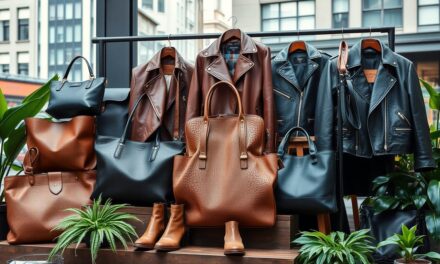Did you know the fashion industry creates over 92 million tons of waste annually? This shows we need a better way to think about fashion. That’s where a capsule wardrobe comes in.
I’m here to show you how to make a wardrobe that’s good for the planet and looks excellent. A capsule wardrobe is more than a trend. It’s a new way to think about your clothes.
The idea of a capsule wardrobe started with Susie Faux in the 1970s. It’s grown into a smart way to buy clothes. By choosing a few key pieces, you can reduce waste while keeping your clothes looking good.
I want to help you create a capsule wardrobe that makes getting dressed easier and helps the planet by reducing waste. We’ll see how picking the right clothes can save time and help the environment.
In this guide, I’ll show you how to make a capsule wardrobe that fits your style. It’s about buying clothes that are good for the planet. Let’s change how we think about clothes together.
Understanding the Capsule Wardrobe Concept and Its Origins
The world of minimalist fashion has changed a lot. It now shapes how we see our essential wardrobe. Exploring this concept showed me a deep history, not just about clothes.
The History of Minimalist Fashion
The capsule wardrobe started in the 1970s. Susie Faux was a pioneer in this area. She opened Wardrobe in 1973 to help women find their style.
- 1973: Susie Faux launches her boutique Wardrobe.
- 1980: Faux defines the capsule wardrobe concept in her book.
- 1985: Donna Karan popularizes the concept with “Seven Easy Pieces”.
Why Sustainable Fashion Matters Today
Today, minimalist fashion is more than a trend. It’s a response to fast fashion’s environmental harm. Now, over 50% of shoppers think about sustainability when buying clothes.
Fashion sustainability metric and percentage chart:
| Fashion Sustainability Metric | Percentage |
| Consumers seeking sustainable options | 60% |
| Brands focusing on seasonless designs | 20% year-over-year growth. |
Benefits of a Minimalist Wardrobe
Choosing a minimalist wardrobe is more than cutting down clothes. It’s about making style choices with purpose.
You can:
- Reduce daily decision fatigue.
- Save money on unnecessary purchases.
- Create a more sustainable personal fashion ecosystem.
- Develop a clearer personal style.
With a minimalist wardrobe, you can make up to 30 different outfits with just a few pieces. This shows that sometimes, less is more in fashion.
Assessing Your Current Wardrobe and Lifestyle Needs
Starting a curated wardrobe means looking closely at what you already have. Most people only wear 20% of their clothes 80% of the time. This means your closet has a lot of hidden gems. I’ll show you how to turn your closet into a space that really works for you.
Here’s how to assess your wardrobe:
- Empty your entire closet and lay out every item.
- Sort clothing into clear categories.
- Evaluate each piece’s functionality and frequency of use.
- Consider your current lifestyle and professional needs.
Tracking how often you wear your clothes can give you great insights. Try keeping a wear tracking log to see which items you love most. This way, you can choose wisely for your capsule wardrobe.
Wardrobe assessment criteria and evaluation points chart:
| Wardrobe Assessment Criteria | Evaluation Points |
| Frequency of Wear | Items worn in last 3-6 months. |
| Condition | Well-maintained, no significant wear/damage. |
| Lifestyle Fit | Matches current work and personal activities. |
| Versatility | Can be mixed and matched with multiple items. |
By using these steps, you’ll be on your way to a wardrobe that’s both stylish and practical. It will show off your personal style and meet your everyday needs.
Defining Your Personal Style and Color Palette
Creating a versatile closet begins with knowing your style and color palette. Your clothes should show who you are and be easy to mix and match.
Capsule Wardrobe Color Palette
When selecting your colors, think about creating a harmonious palette. Choose a few shades that complement each other beautifully!
Experts say to pick 6-9 colors, with a mix of:
- 1-3 neutral base colors (black, white, gray, navy).
- 2-5 accent colors that match your skin tone.
- A good balance of base to accent colors.
Choosing Your Core Neutral Colors
Neutral colors are key for a versatile closet. They help you mix and match outfits easily.
Think about these classic neutrals:
- Classic black.
- Soft gray.
- Crisp white.
- Warm camel.
Incorporating Accent Colors Strategically
Accent colors add personality to your clothes. Try to have 2-5 colors that match your neutrals. These colors should make up about 25% of your wardrobe, adding interest without losing cohesion.
Identifying Silhouettes That Work for You
Knowing your body type is key for choosing flattering clothes. A good capsule wardrobe has pieces that match in color and flatter your shape. This ensures you look and feel great in every outfit.
Essential Pieces for Your Capsule Wardrobe
Starting a capsule wardrobe means picking pieces that go well together. I choose quality over quantity. This way, each item can be used in many ways.
Capsule Wardrobe Essentials
Here are the main categories to consider:
- Tops: Neutral-colored t-shirts, button-downs, and layering pieces.
- Bottoms: Well-fitted jeans, tailored trousers, and versatile skirts.
- Outerwear: Classic blazer, lightweight jacket, and winter coat.
- Shoes: Comfortable walking shoes, dressy boots, and versatile sneakers.
Here’s how many pieces you should have for each category:
| Clothing Category | Recommended Pieces | Price Range |
| Tops | 5-7 Pieces | $30-$200 |
| Bottoms | 3-5 Pieces | $100-$300 |
| Outerwear | 2-3 Pieces | $200-$1,500 |
| Shoes | 3-5 Pieces | $145-$500 |
Invest in quality pieces that can be mixed and matched. Brands like Everlane, Cos, and Toteme are great for a timeless wardrobe. Aim for outfits that use minimal pieces.
Choosing versatile pieces simplifies your wardrobe. It reduces decision-making and makes your style more sustainable.
Sustainable Materials and Quality Indicators
Starting a sustainable style in your capsule wardrobe means choosing the right materials. The fabrics we pick can greatly reduce our environmental footprint and make clothes last longer.
Sustainable Fabric Quality Indicators
When picking clothes for your capsule wardrobe, go for high-quality materials. Natural fibers are durable and good for the planet. Here are the top sustainable fabric picks:
Natural Fiber Options
- Organic Cotton: Uses up to 91% less water than regular cotton.
- Lyocell TENCEL™: It’s biodegradable and made in a closed-loop system.
- Organic Wool: It’s renewable and keeps you warm or cool naturally.
- Alpaca Wool: Can last up to 20 years with the right care.
Understanding Fabric Durability
Choose fabrics that last a long time. A well-made piece can last 50-200% longer than cheap clothes.
Fabric type, durability rating and environmental impact chart:
| Fabric Type | Durability Rating | Environmental Impact |
| Organic Cotton | High | Low Water Usage. |
| Lyocell TENCEL™ | Very High | Minimal Waste. |
| Alpaca Wool | Extremely High | Sustainable Sourcing. |
Care Instructions and Longevity
Right care can make your clothes last longer. Wash less, repair more should be your motto. Learn how to care for each fabric to make them last.
- Wash in cold water.
- Air dry when possible.
- Mend small tears immediately.
- Store garments properly.
By choosing quality materials and caring for them right, you’ll have a capsule wardrobe that’s stylish, durable, and eco-friendly.
Building a Mix-and-Match Wardrobe System
Creating a versatile closet is more than having fewer clothes. It’s about making the most of each piece. My method turns a small wardrobe into a treasure trove of outfits.
Mix And Match Clothing Versatile Closet
The key to a great wardrobe is its flexibility. With just 9 key pieces, you can make 27 unique outfits. This is achieved by mixing and matching 3 bottoms, 3 inner tops, and 3 outer tops in creative ways.
- Choose neutral base colors that complement each other.
- Select pieces with complementary textures and styles.
- Focus on layering techniques to expand outfit options.
Layering is the secret to a versatile closet. A simple blazer can turn a casual look into a professional one. A lightweight cardigan adds warmth and depth to your outfit.
Clothing category, recommended pieces and outfit potential:
| Clothing Category | Recommended Pieces | Outfit Potential |
| Bottoms | Dark jeans, neutral trousers, versatile skirt | Multiple styling options. |
| Tops | White shirt, neutral sweater, solid color tee | Easy mix and match. |
| Outerwear | Blazer, denim jacket, lightweight coat | Instant outfit transformation. |
Keeping a record of your outfits can change the game. I suggest taking photos of your successful combinations. This way, you can quickly find inspiration when getting dressed, making mornings easier.
Shopping Strategies for Sustainable Fashion
Finding sustainable fashion requires smart shopping. It’s about choosing items that are both good for the planet and stylish. I’ve learned how to build a wardrobe that’s both ethical and fashionable.
Second-Hand Shopping Tips
Thrifting is a big win for those who care about the planet. It’s grown by 27% in recent years.
Here are my best tips:
- Explore online platforms like ThredUp and Poshmark.
- Visit local consignment stores and vintage shops.
- Check out community clothing swap events.
- Use apps that specialize in second-hand clothing.
Researching Ethical Brands
When buying new clothes, look for brands that care about the planet. Check if they have clear supply chains and ethical certifications.
Brand sustainability criteria and what to look for:
| Brand Sustainability Criteria | What To Look For |
| Material Sourcing | Organic, recycled, or low-impact materials. |
| Labor Practices | Fair wages, safe working conditions. |
| Environmental Impact | Reduced water usage, low carbon emissions. |
Investment Pieces Worth Splurging On
Investing in quality items can change your minimalist style. Choose timeless pieces that are versatile and last long. Spending more can mean your clothes last up to 20% longer.
- Classic blazer.
- High-quality denim.
- Versatile leather shoes.
- Sustainable wool coat.
By using these tips, you’ll not only lessen your fashion impact. You’ll also create a wardrobe that shows your dedication to sustainable fashion.
Maintaining and Caring for Your Sustainable Wardrobe
Keeping your essential wardrobe in top shape needs careful thought and maintenance. It’s not just about picking the right clothes. It’s also about making them last for a long time.
There are a few important steps to take care of your clothes:
- Follow the care labels on your clothes.
- Choose eco-friendly detergents.
- Wash clothes in cold water.
- Let them air dry to avoid wear.
Knowing how to take care of different fabrics is key. Materials like organic cotton and Tencel need special care to stay looking good and feeling soft.
Care technique, benefit and recommended frequency chart:
| Care Technique | Benefit | Recommended Frequency |
| Cold Water Wash | Reduces fabric wear | Always. |
| Air Drying | Prevents shrinkage | Most garments. |
| Gentle Detergent | Preserves fabric integrity | Every wash. |
Learning to mend clothes can change how you care for them. Spending time on small fixes can stop you from throwing things away too soon. It also helps the planet.
- Learn simple sewing techniques.
- Keep a basic repair kit.
- Consider professional tailoring for complex repairs.
By following these care tips, you’ll keep your sustainable wardrobe in great shape. You’ll also help cut down on waste from clothes.
Conclusion
Creating a capsule wardrobe is not about being perfect. It’s a journey of sustainable style that grows with you. I learned that having 33-37 carefully chosen pieces is freeing, not limiting. It’s about knowing what you need and feeling good in what you wear.
A capsule wardrobe is flexible. You don’t have to change clothes every three months. It’s about making your wardrobe fit your life. Choose pieces that make you feel good, no matter where you are.
Sustainable style is a learning curve. I found that comfort is more important than strict fashion rules. It’s about picking what feels right, like Columbia shorts, and keeping your wardrobe interesting. It’s about being mindful of what you buy and reducing waste.
Building a capsule wardrobe empowers you to make better fashion choices. It’s not about limiting yourself but about creating a collection that shows who you are. Start small, be patient, and enjoy making a wardrobe that suits you.
Frequently Ask Questions (FAQ)
What exactly is a capsule wardrobe?
A capsule wardrobe is a collection of essential, high-quality clothes. These pieces can be mixed and matched to create many outfits. It’s about having a few key items in colors and styles that work well together, making your wardrobe versatile and clutter-free.
How many pieces should be in a capsule wardrobe?
There’s no one-size-fits-all answer, but most have 25-40 pieces. This includes tops, bottoms, outerwear, and accessories. The goal is to have items that can be worn in different ways, making your wardrobe more flexible with fewer pieces.
Is a capsule wardrobe expensive to create?
Not always. While quality pieces might cost more upfront, a capsule wardrobe can save you money in the long run. By choosing items that are versatile and well-made, you’ll spend less on clothes and have a more sustainable wardrobe.
How do I start building my capsule wardrobe?
Start by reviewing your current wardrobe and picking out your favorites. Define your style and choose a color palette. Then, replace items that don’t fit your new style with pieces that are versatile and can be mixed and matched.
Can a capsule wardrobe work for different lifestyles?
Yes! A capsule wardrobe is very flexible. It can be tailored to fit any lifestyle, whether you work outside the home, are a stay-at-home parent, or have a creative job. You can make it your own to match your personal style and needs.
How often should I update my capsule wardrobe?
Most people update their wardrobe seasonally or every 3-4 months. This lets you change up your clothes with the weather and add new items. It also helps you keep a core collection of basics that you can always rely on.
What are the environmental benefits of a capsule wardrobe?
A capsule wardrobe greatly reduces fashion waste. By buying fewer, better-made items and avoiding fast fashion, you cut down on waste and lower your carbon footprint. It supports more sustainable fashion practices.
How do I choose the right pieces for my capsule wardrobe?
Look for versatile, high-quality pieces that fit well and go together. Choose neutral colors and classic styles. Focus on comfort and quality, and pick items that make you feel good about yourself.




















